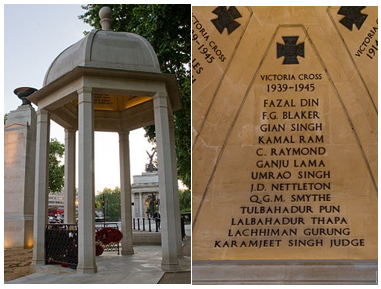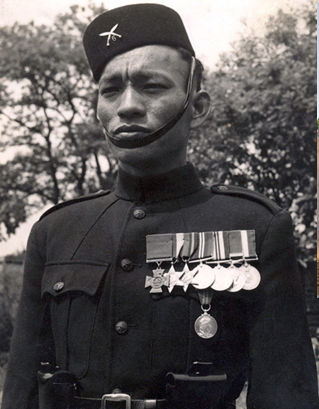Tul Bahadur Pun, Gurkha in the Indian Army, Recipient of the Victoria Cross
Tul Bahadur Pun VC (23 March 1923 (or 1919) -20 April 2011) was a Nepalese Gurkha recipient of the Victoria Cross, the highest award for gallantry in the face of the enemy that can be awarded to British and Commonwealth forces. He later achieved the rank of Honorary Lieutenant. In addition to the Victoria Cross, Pun was awarded 10 other medals, including the Burma Star.
Pun was 21 years old, and a Rifleman in the 3rd Battalion, 6th Gurkha Rifles, in the Indian Army during World War II when the following deed took place for which he was awarded the VC.
On 23 June 1944 at Mogaung, Burma, during an attack on the railway bridge, a section of one of the platoons was wiped out with the exception of Rifleman Tul Bahadur Pun, his section commander and one other. The section commander immediately led a charge on the enemy position but was at once badly wounded, as was the third man. Rifleman Pun, with a Bren gun continued the charge alone in the face of shattering fire and reaching the position, killed three of the occupants and put five more to flight, capturing two light machine-guns and much ammunition. He then gave accurate supporting fire, enabling the rest of his platoon to reach their objective.
Citation :War Office, 9th November, 1944
The KING has been graciously pleased to approve the award of the VICTORIA CROSS to:-No. 10119 Rifleman Tul bahadur Pun, 6th Gurkha Rifles, Indian Army.
In Burma on 23 June 1944, a Battalion of the 6th Gurkha Rifles was ordered to attack the Railway Bridge at Mogaung. Immediately the attack developed the enemy opened concentrated and sustained cross fire at close range from a position known as the Red House and from a strong bunker position two hundred yards to the left of it.
The cross fire was so intense that both the leading platoons of ‘B’ Company, one of which was Rifleman Tulbahadur Pun’s, were pinned to the ground and the whole of his Section was wiped out with the exception of himself, the Section commander and one other man. The Section commander immediately led the remaining two men in a charge on the Red House but was at once badly wounded. Rifleman Tulbahadur (sic) Pun and his remaining companion continued the charge, but the latter too was immediately wounded.
Rifleman Tulbahadur Pun then seized the Bren Gun, and firing from the hip as he went, continued the charge on this heavily bunkered position alone, in the face of the most shattering concentration of automatic fire, directed straight at him. With the dawn coming up behind him, he presented a perfect target to the Japanese. He had to move for thirty yards over open ground, ankle deep in mud, through shell holes and over fallen trees.
Despite these overwhelming odds, he reached the Red House and closed with the Japanese occupants. He killed three and put five more to flight and captured two light machine guns and much ammunition. He then gave accurate supporting fire from the bunker to the remainder of his platoon which enabled them to reach their objective.
His outstanding courage and superb gallantry in the face of odds which meant almost certain death were most inspiring to all ranks and beyond praise.
—Supplement to the London Gazette, 7 November 1944 (dated 9 November 1944)

“Memorial Gates”, Constitution Hill, London/ Inscription of Tul Bahadur Pun VC’s name on the “Memorial Gates” at Constitution Hill, London In addition, as a winner of the Victoria Cross, his name is inscribed on memorials at Westminster Abbey and the Union Jack Club, in London, and on the “Memorial to the Chindits” on the north side of the Victoria Embankment next to the Ministry of Defence headquarters in London.
On 01 June 2007, Pun was granted British citizenship. On 20 April 2011, He returned home to Nepal to see the completion of a school for the village, a project which he had been involved with. Pun died unexpectedly in his home village of Myagdi, Nepal. He was 92 years old.





